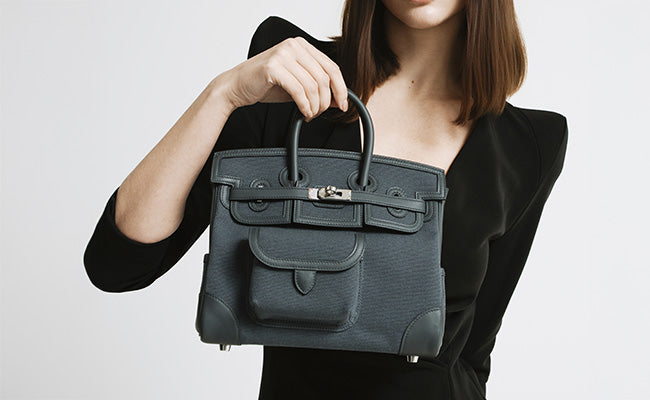
Handle Darkening: Causes, Prevention, and Gentle Remedies
Check out our Hermès collection and Birkin bags!
Watching the handles of your cherished Hermès bag darken can feel like a slow heartbreak. This change, called patina, happens as leather meets the oils from our hands, sunlight, and whatever else life throws at it.
Sure, a bit of patina can tell a story and give your bag some soul, but when it goes too far or gets patchy, it can really take away from the bag’s beauty and even its value.
Whether you’re toting a Birkin or holding onto a vintage Kelly, knowing how to prevent and tackle handle darkening helps keep your luxury bags looking sharp for years.
So, what’s really behind this phenomenon? Let’s dig into the causes and find out how to protect our favorite pieces.
Key Takeaways
- Handle darkening happens naturally when leather meets skin oils, sunlight, and the environment, building up patina over time.
- Gentle cleaning, protective treatments, and smart storage can slow the process and help maintain your bag’s value.
- If darkening already set in, there are both professional and careful at home remedies that can make a difference without harming the leather.
What Is Handle Darkening?
Handle darkening is when leather bag handles pick up a deeper color from contact with our skin and its oils. It changes the look and sometimes even the value of luxury handbags, especially those made with unfinished or lightly treated leathers.
Definition and Types of Handle Darkening
You’ll notice handle darkening most on Hermès Birkin and Kelly bags. That natural vachette leather loves to soak up a story over time.
Here’s what you might see:
- Uniform darkening: The whole handle deepens in color, pretty evenly.
- Uneven pigmentation: Some spots get darker than others, usually where you grab the most.
Light shades like Gold, Chai, and Craie really show it. The leather grabs onto skin oils, and those color changes? They’re not going anywhere.
Some folks actually love this look and call it “beautiful patina.” Others, not so much, especially if they care about resale.
The Role of Skin Contact and Daily Use
Every time you pick up your bag, your skin leaves behind oils, sweat, and whatever else you’ve got on your hands. Hand lotion, sunscreen, and makeup? They speed things up.
The most-gripped parts of the handles darken first. It’s just what happens when you love a bag.
What makes it worse?
- How often you use the bag
- How long you carry it around
- Your skin’s pH
- Hand creams or other products
- Humidity
Even with careful handling, you can’t stop it completely. Untreated leather just soaks up whatever touches it, and that’s that.
Impact on Bag Value and Aesthetics
Handle darkening can really hit the look and value of your luxury bags. Heavily darkened handles might knock 20 to 40% off the resale price.
Some collectors are fine with a gentle, even patina. But if it’s patchy or just too much, the bag’s appeal and price drop fast.
What changes?
- The original color fades
- The bag starts to look uneven
- Handles and body might not match
- The whole thing can look more worn than you’d like
Resellers and auction houses pay close attention to handle condition when they set prices.
Leading Causes of Handle Darkening
Why do our luxury handles darken in the first place? It’s not just one thing. UV exposure, natural oils, friction, skincare products, and the type of leather all play a part.
Sun Exposure and UV Rays
Our bags face the same sun we do. UV rays get into the leather, changing its chemistry and making it darker over time.
Direct sunlight speeds up reactions in the leather’s tannins and dyes. Leaving your bag in the car on a summer day or by a sunny window? That’ll do it.
Vegetable-tanned leathers, with their melanin-like compounds, darken faster than chrome-tanned ones.
It’s not just how long, but how strong the light is. A few hours of blazing sun can do more damage than weeks of indoor light.
Leathers with shiny or heavy finishes handle the sun better. Natural, untreated ones? Not so much.
Hand Oils, Sweat, and Friction
Our hands are oily, and luxury leather doesn’t hide it. Some people just leave more marks than others.
Friction from carrying your bag creates tiny abrasions, letting oils sink in deeper. The more you use your bag, the faster it happens.
Sweat brings salt into the mix, which can mess with the dyes and leave marks that regular cleaning won’t fix.
Warm weather? It makes your hands oilier and the leather more absorbent.
Put it all together, and it’s no wonder bags you use every day darken way faster than those you only take out for special occasions.
Impact of Skincare and Fragrances
What we put on our skin ends up on our bags. Hand creams, perfumes, sunscreen, all of them can react with leather.
Alcohol in fragrances strips away protective finishes. Spritz perfume, grab your bag, and you’re transferring chemicals straight onto the leather.
Sunscreens with zinc oxide or titanium dioxide can leave white marks and even change the color of the leather.
Hand sanitizers, especially lately, are rough on leather. The alcohol dries it out and leaves chemicals behind.
If your skincare products are really acidic or alkaline, they can throw off the leather’s balance, changing how it ages.
Genetic Predisposition and Skin Tone
Our own body chemistry matters. Some people just have skin that’s more acidic or oily, and that affects how their bags age.
If you have naturally oily skin, you’ll probably see handle darkening faster, no matter how careful you are.
Skin tone itself doesn’t cause darkening, but the way your skin produces oils and melanin can affect the process.
People who run warm or sweat more will notice faster darkening, too. And if you live somewhere humid, your skin chemistry might lean different than someone in a dry place, changing how your touch affects the leather.
Handle Darkening and Underlying Skin Conditions
Sometimes, it’s more than just everyday use. Certain medical conditions can cause hands to develop dark patches, which can transfer to your luxury handles.
Hyperpigmentation and Melasma
Melasma gives you those stubborn brown patches nobody asked for. It usually shows up with hormonal shifts. Think pregnancy or birth control.
Common triggers:
- Hormonal changes (pregnancy, birth control)
- Sun on unprotected hands
- PCOS hormone swings
Post-inflammatory hyperpigmentation can pop up after your skin gets irritated or scratched. Yes, even from your bag.
The patches can be brown, tan, or grayish. They stick around way longer than a tan.
Sun makes melasma worse, so if you’re dealing with it, sun protection is a must.
Acanthosis Nigricans and Insulin Resistance
This one creates velvety, dark patches, usually where skin rubs together. Knuckles, between fingers, around rings.
Key signs:
- Thick, dark, almost velvety skin
- Usually shows up on both hands
- Most common on knuckles and joints
It’s often linked to insulin resistance and type 2 diabetes. Your body makes extra insulin, which ramps up skin cell growth and pigmentation.
PCOS can cause this too, thanks to insulin resistance.
Also seen with:
- Type 2 diabetes
- Obesity
- Thyroid issues
- Liver problems
Tackling the insulin resistance, diet, exercise, medical care, usually helps the skin clear up.
Eczema, Psoriasis, and Allergic Reactions
Inflammatory skin conditions can leave dark spots behind even after the flare-up fades. Our hands, always in action, take the brunt.
Eczema causes dry, itchy patches that can heal with dark marks. Scratching and inflammation make your skin pump out more pigment.
Psoriasis leaves thick, scaly spots that sometimes darken after treatment.
Irritants that can trigger reactions:
- Strong soaps and sanitizers
- Jewelry metals (nickel, copper)
- Cleaning chemicals
- Fragrances in lotions
Allergic reactions from rings, watches, or products can leave dark spots too. Sometimes even that fancy hand cream isn’t your friend.
Best bet? Figure out what’s setting you off and avoid it. Stick to gentle, fragrance-free stuff when your skin’s acting up.
Gentle Remedies to Reduce Handle Darkening
Fighting handle darkening means sticking to gentle cleansing, using brightening ingredients, and keeping skin hydrated. These steps help turnover cells and even out your skin tone.
Mild Cleansing and Exfoliation
The trick is to clean and exfoliate without overdoing it. Harsh scrubbing just makes things worse.
Daily cleansing: Go for pH-balanced cleansers that won’t strip your skin. Treat your hands the way you treat your bag. Skip the harsh stuff.
For exfoliation, try a simple homemade scrub:
- Mix equal parts sugar and olive oil
- Gently rub in circles for a few minutes
- Start with 2 to 3 times a week, then drop to once a week to maintain
Oatmeal is another gentle option. The goal is to help skin renew itself without causing irritation.
Using Antioxidant and Brightening Products
Picking the right products matters. You want things that help with pigmentation but are still kind to your skin.
Niacinamide (a form of vitamin B3) is gentle and helps fade dark spots. Use a thin layer once a day. If you get a little irritation at first, it usually calms down.
Kojic acid from soy can lighten pigmentation, especially in stable formulas.
Vitamin C serums are great for brightening and protecting. Try pairing with niacinamide, but go slow to avoid sensitivity.
Natural options: Some folks swear by lemon juice with baking soda (equal parts, leave on for about 20 minutes daily), but always moisturize after. Citrus can dry you out.
Hydration and Moisturising Habits
Moisturizing matters. Dry skin is more likely to darken, so keep those hands hydrated.
Moisturize right after washing, while your skin’s still a bit damp. It locks in moisture better.
Look for hand creams with ceramides, hyaluronic acid, or glycerin. Reapply during the day, especially after washing or if you’re out in the elements.
Overnight treatments can work wonders. Slather on a thicker cream before bed and let it do its thing.
Don’t skip sunscreen. UV rays make pigmentation worse. Go for broad-spectrum SPF 30 or higher, even if it’s cloudy. Lots of hand creams have SPF now, which is handy.
Keeping skin hydrated supports its natural barrier and helps it renew, giving you the best shot at fading dark spots.
Professional and At-Home Treatments
If handle darkening just won’t budge, it might be time to try stronger options. Professional treatments can deliver faster results, and prescription products pack more punch than what you’ll find over the counter.
When to Consult a Dermatologist
It’s time to call a dermatologist when your luxury bag handles keep darkening despite all your careful routines. If the discoloration spreads quickly or you notice other skin changes, don’t wait. Get a professional’s opinion.
Red flags that mean you shouldn’t put it off:
- Darkening that sticks around after 6 to 8 weeks of gentle home care
- Spots that feel raised, rough, or look uneven at the edges
- Areas that start hurting or itching
A dermatologist will figure out if you’re dealing with simple friction darkening or something more complicated. They’ll look at the spots, maybe do patch testing to see if you’re reacting to leather treatments or metals from bag hardware.
Getting the right diagnosis means you’re not just guessing and hoping for the best. It saves you time, keeps things from getting worse, and protects your investment in those Hermès treasures.
Topical and Prescription Remedies
When stubborn handle darkening refuses to budge, prescription treatments usually get the job done. Hydroquinone is still the top pick for fading hyperpigmentation, but you’ll need a prescription for the stronger 2 to 4% versions.
Retinoids like tretinoin and adapalene help skin shed old cells, speeding up the fading of dark spots. They’re especially good for those age or liver spots that pop up on hands from sun exposure while you’re out and about with your bags.
Some common prescription combos:
- Hydroquinone 4% with tretinoin 0.05%
- Kojic acid plus arbutin
- Tranexamic acid for melasma-like darkening
You might see some improvement in 4 to 6 weeks, but real results can take 3 to 4 months. These meds make your skin more sensitive to the sun, so sunscreen isn’t optional.
Side effects like mild peeling or redness can happen, but starting low and slow helps your skin adjust.
Professional Procedures: Peels and Lasers
If you’re impatient for results, in-office treatments can speed things up. Chemical peels use acids to lift away damaged skin, letting fresher skin show through.
Peel options, from mild to intense:
- Light peels (glycolic, lactic): little downtime, subtle difference
- Medium peels (TCA): you’ll peel for about a week, but get more noticeable results
- Deep peels: require recovery time, but can really transform things
Lasers like Fraxel target pigment directly. They create tiny treatment spots, so you heal faster while still tackling age spots and sun damage.
Laser hair removal is another option if hair growth around handles is causing friction and darkening.
Most of these procedures need 3 to 6 sessions, spaced out every month or so. You’ll have to give your favorite bags a break while healing, but with good sun protection, results can last for years.
These treatments work fast, but they’re pricier and you’ll need to plan for some downtime.
Prevention Tips for Luxury Bag Enthusiasts
If you want to keep your luxury bags looking their best, you need to think about how your daily habits and skincare choices affect those leather handles. The mix of oils from your hands and whatever’s on your skin is a recipe for darkening.
Sunscreen and Protective Gloves
Sunscreen is a sneaky culprit when it comes to handle darkening on Hermès bags. Those UV filters and titanium dioxide particles get on your hands, then transfer right onto the leather.
Timing is everything. Put on sunscreen at least 15 minutes before you touch your bag. Oil-based sunscreens are especially risky for pale leathers like Craie or Galet.
For your most prized bags, lightweight cotton gloves are surprisingly effective. Sure, it might feel a bit much at first, but think about how museum staff handle priceless art.
Glove options worth trying:
- White cotton photography gloves for dressy moments
- Thin nitrile gloves for everyday errands
- Silk liner gloves if you want something a bit more refined
Look for gloves that are thin enough so you don’t feel clumsy, but still keep skin from touching the leather.
Optimizing Skincare Before Handling
Your skincare routine can make a big difference in how quickly handles darken. Heavy hand creams, antiperspirants, and certain actives leave residue that ends up on your bag.
A few tweaks go a long way. Wait at least 20 minutes after hand cream before grabbing your bag. Avoid products with glycolic acid or retinoids on your hands. They’re especially tough on leather.
Even your habits matter. Smoking, for example, increases skin’s oxidative stress, making your natural oils more acidic and damaging to leather.
Ingredients to be wary of:
- Aluminum in antiperspirants
- Heavy, greasy moisturizers
- Self-tanners on hands
- Hair removal creams (leftover residue)
It helps to keep your skin healthy overall. Well-hydrated skin from the inside out means less problematic oils than skin that’s dry and over-moisturized.
Bag Care Routines and Storage
Good habits make all the difference. You want storage and handling routines that protect your bags but don’t make them feel too precious to use.
Storage basics:
- Always use dust bags
- Cedar shoe trees to hold the shape
- Store in climate-controlled spots (skip the basement)
- Rotate your bags so none get overused
Wipe down handles with a barely damp microfibre cloth every week to stop oils from sinking in.
Smart ways to handle your bags:
- Carry by the body or strap when you can, not always by the handles
- Use organizers inside to cut down on friction
- Switch hands often if you’re carrying for a while
Temperature is more important than you’d think. Heat speeds up oil absorption, so never leave bags in cars or near heaters.
The most expensive bags deserve the most care. A Birkin or Kelly isn’t just a bag. It’s a piece of art that should last for generations.
Frequently Asked Questions
Luxury leather care isn’t just about basic cleaning. It’s a whole world of tricks and expertise. Here are some answers to the questions that come up most when you’re trying to keep your investment pieces looking flawless.
What haute couture secrets can prevent my handbag's leather from turning a shade darker?
Honestly, conditioning before you see any dryness is a game-changer. High-end ateliers treat their bags every 3 to 4 months with top-notch leather creams made from natural oils like mink or neatsfoot.
Temperature control is huge. We keep Birkins and Kellys in rooms set at 18 to 21°C, with humidity around 45 to 55%.
Applying a professional leather protector before you ever use the bag helps keep oils from soaking in.
In the world of luxury, how do elite stylists tackle the fading of their high-end leather accessories?
Celebrity stylists almost always send valuable pieces to professional restoration services. Trying to fix Hermès or Chanel bags at home usually makes things worse.
Experts use color-matched dyes to restore faded spots and keep the bag’s structure and value intact.
Light-colored leathers get attention right away. The sooner you address fading, the better your results.
Is there a bespoke regimen for maintaining the pristine look of my designer bag's original colour?
Monthly inspections catch color changes early, especially around handles and corners.
A weekly wipe-down with a pH-neutral leather cleaner and a damp microfibre cloth helps keep oils from seeping in.
Don’t use the same bag every day. Rotation helps the leather rest and last longer.
What's the champagne of skin care for those ritzy leather pieces that seem to lose their lustre over time?
Premium conditioners with lanolin and beeswax bring back suppleness without darkening. We use them sparingly, working in circles and letting them absorb for a day.
Once a quarter, a professional-grade leather balm acts like a deep moisturizer, especially for areas that dry out.
A horsehair brush gives a gentle buff to restore shine. Just a few light, circular strokes after conditioning does the trick.
For the crème de la crème of my wardrobe, what are the top non-invasive treatments for counteracting leather darkening?
UV protection films, applied by pros, shield bags from light damage without changing how they look. We use these for bags displayed in bright rooms.
Special leather erasers can lift surface stains that lead to darkening. Always test on a hidden spot first, especially with exotic leathers.
Professional steam treatments sometimes lighten darkened leather. Certified specialists use controlled moisture to safely bring back the original tones.
Can you spill the tea on any DIY gentle remedies recommended by luxury lifestyle connoisseurs for keeping handbags in tip-top, runway-ready condition?
Honestly, most of us just wash our hands well before grabbing those pale beauties. Body oils? They're the sneaky villain behind those darkened handles on your favorite luxury bags. Nobody wants that.
Some folks swear by white cotton gloves when they're putting bags away or snapping photos. Just slip 'em on, and you won't have to stress about oily fingerprints.
Oh, and don't forget those little silica gel packets. Toss a few in your storage boxes to keep things dry. Swap them out every month or so. And please, skip the plastic bags. Leather needs to breathe, not sweat.




